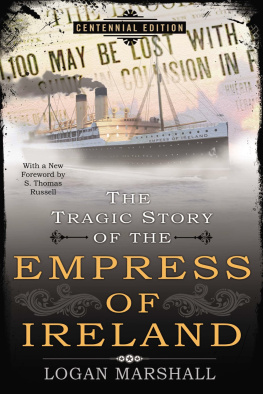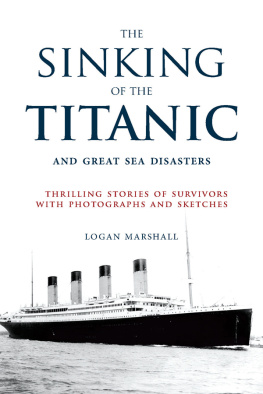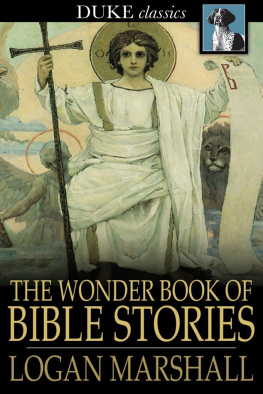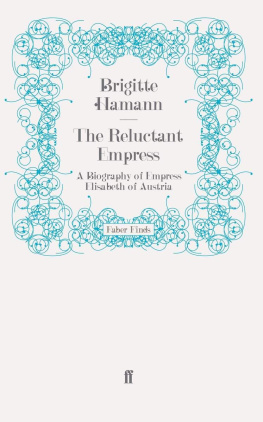THE EMPRESS OF IRELAND
One of the finest ships of the Canadian line. Soon After leaving Quebec on her voyage to Liverpool with over 1300 souls on board, she was struck by the Norwegian collier Storstad off Father Point, Quebec, on May 29, 1914, at 2:10 A.M., and sank about fifteen minutes later, carrying a thousand passengers down with her.
THE
TRAGIC STORY
OF THE
EMPRESS OF IRELAND
Logan Marshall
THE BERKLEY PUBLISHING GROUP
Published by the Penguin Group
Penguin Group (USA) LLC
375 Hudson Street, New York, New York 10014

USA Canada UK Ireland Australia New Zealand India South Africa China
penguin.com
A Penguin Random House Company
Introduction copyright 2014 by S. Thomas Russell
Penguin supports copyright. Copyright fuels creativity, encourages diverse voices, promotes free speech, and creates a vibrant culture. Thank you for buying an authorized edition of this book and for complying with copyright laws by not reproducing, scanning, or distributing any part of it in any form without permission. You are supporting writers and allowing Penguin to continue to publish books for every reader.
BERKLEY is a registered trademark of Penguin Group (USA) LLC.
The B design is a trademark of Penguin Group (USA) LLC.
Berkley trade paperback ISBN: 978-0-425-27354-8
eBook ISBN: 978-0-698-15132-1
PUBLISHING HISTORY
Previously published as The Tragic Story of the Empress of Ireland and Other Great Sea Disasters by L.T. Yers in 1914.
Berkley trade paperback edition / April 2014
Cover art and design by Oyster Pond Press
Interior text design by Tiffany Estreicher
While the author has made every effort to provide accurate telephone numbers and Internet addresses at the time of publication, neither the author nor the publisher is responsible for errors, or for changes that occur after publication. Further, the publisher does not have any control over and does not assume any responsibility for author or third-party websites or their content.
Version_2
CONTENTS
FACTS ABOUT THE WRECK OF THE EMPRESS OF IRELAND
Number of persons aboard: 1,477
Number of persons saved: 465
Number of persons dead: 1,012
Total number of first-class passengers: 87
Total number of second-class passengers: 253
Total number of third-class passengers: 717
Total number of crew: 420
The Salvation Army delegation numbered 150; of these 124 were lost.
The Empress of Ireland was a twin-screw vessel of 14,500 tons.
The vessel was built in Glasgow in 1906 by the Fairfield Company, Ltd., and was owned by the Canadian Pacific Railway.
The Storstad was a single-screw vessel, registering 6,028 tons.
The vessel was built by the Armstrong, Whitworth Company at Newcastle in 1911, and is owned by the Dampsk Aktieselk Maritime of Christiania, Norway.
FOREWORD
I n May of 1914 the world did not appear to be on the verge of cataclysm. March of that year saw Babe Ruth play his initial game as a professional. Charlie Chaplin appeared in his first film, and a few months later, the Tramp made his debut. The last-known passenger pigeon did die in the Cincinnati zoo, bringing that once-numerous species to its final end, but apparently few saw this as an omen of things to come. Richard Patrick Russ was born, though he would not change his name to Patrick OBrian and begin living the famous lie for some time. William S. Burroughs and Sonny Boy Williamson made their appearance on the planet, as did Dylan Thomas, Hedy Lamar, Jackie Coogan, and Dorothy Lamour. Given that list of luminaries (and it is far from complete), one would think it was in fact an auspicious year. A year that marked great things to come. But then, 1914 also saw the introduction of the hobble skirt (wide at the hips but so narrow at the ankles it made a normal stride impossible). Like the fashion world, mankind stumbled, guilelessly, into the summer of that year and the opening weeks of the War to End All Wars. In the next few years over sixteen million would die as a direct result of that conflict and twenty million more would be wounded.
It is not surprising, given the early dateMay 28that the passenger liner Empress of Ireland departed her berth in Quebec City with the usual fanfare, goodbyes, and excitement. She was not new to the route, having crossed the Atlantic numerous times, and her captain, though new to the ship, was an experienced officer of good reputation and many years experience. Twelve hours later the Empress was lying on the bottom in relatively shallow water and over a thousand people, who had waved to friends as they boarded, were dead. Her position, unlike more famous wrecks, was never a great mystery, and she has been reachable by divers from fairly early days. Had she sunk by daylight, land would have been visible, and had the waters been warm, a strong swimmer could have reached the shore.
The loss of the Empress of Ireland followed on the heels of the sinking of the Titanic two years earlier, on April 15, 1912, and preceded, by three years, the loss of the Lusitania, May 7, 1915. Over 3,700 lives were lost from the three ships, 1,012 from the Empress alone. (A fourth sinking, less well known, was the SS Eastland, which rolled over in her berth in Chicago, drowning over 800 passengers and crew.) From the vantage of a century later, the sinkings of these passenger liners in the early years of the twentieth century seem like a warning of the limits of technology and science, but then usable radar had not yet been developed, which almost certainly would have prevented two of the accidents. (Several inventors, including Marconi and Tesla, had suggested that radio waves could be used to detect and determine the course and speed of ships but no one seemed to take this idea seriously for many years.)
The sinking of the Lusitania, by a German submarine off the coast of Ireland, evokes, even today, deep feelings of anger and outrage, though divers have established beyond all doubt that she did carry war munitions. She was the swiftest, and briefly, largest liner of her time but went to the bottom in fewer than twenty minutes after being struck by a torpedo.
The Titanic, certainly the most famous loss of a ship in modern times, has been the subject of countless movies, books, and documentaries. The largest ship of her day, and advertised as unsinkable, her loss became a story of hubris, tragedy, and oddly, romance. The sinking of the Titanic seemed to signal the end of an era, with images of those first-class passengers in black tie, kicking bits of the iceberg about the deck and having a good laugh. Every film seems to have a romance, the most recent featuring the young Kate Winslet and Leonardo DiCaprio engaged in their doomed love affair. The fact that the



















